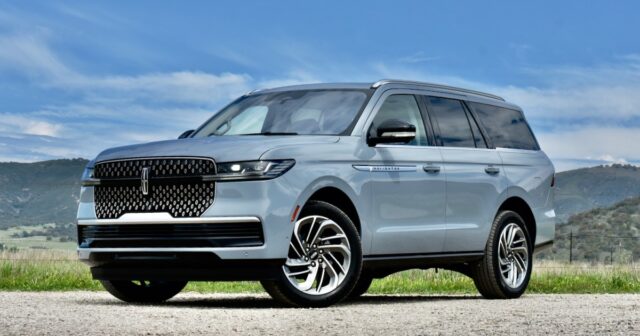2025 Lincoln Navigator review: new looks and tech, same throwback driving dynamics
MSRP $101,990.00
“Lincoln’s redesigned flagship maintains the upscale feel of its predecessor, but doesn’t improve on it.”
Pros
- Looks upscale inside and out
- Impressive dashboard display
- Torquey twin-turbo V6 engine
- Helpful split tailgate
Cons
- Touchscreen-reliant interface
- Pricier than rivals
- Still feels truck-like
The 2025 Lincoln Navigator is one of the most aptly-named vehicles on the market. Redesigned for the current model year, it’s a full-size, three-row SUV of titanic proportions, from a luxury brand named after a dead president.
This combination has proven a winner with customers, facilitating Lincoln’s shift away from sedans like the Continental to an all-SUV lineup of which the Navigator is the flagship. In its latest refit, the Navigator gained Lincoln’s latest infotainment tech — with expanded screen space and capabilities — while keeping the truck-like body-on-frame design used by previous generations dating back to the nameplate’s 1998 launch.
Since that time, the Navigator has accumulated rivals working off a similar template, including the Cadillac Escalade and Infiniti QX80. While similar money will buy you a more sensibly-proportioned BMW X7, Land Rover Range Rover, Lexus LX, or Mercedes-Benz GLS-Class, The Navigator continues to play in that plus-sized sub-class.
2025 Lincoln Navigator: design
The previous-generation Navigator set the tone for the rest of Lincoln’s lineup, but product-launch cadence means the new Navigator takes its cues from the smaller Lincoln Nautilus SUV launched last year. The studded grille with a centered Lincoln badge flanked by horizontal bars (with optional illumination) and wing-tipped headlights mounted high on the fenders all follow the course charted by the Nautilus.
The Navigator is a very different vehicle, though. It’s not only much bigger, but instead of the Nautilus’ more common unibody construction, it shares a body-on-frame platform with the redesigned 2025 Ford Expedition. The body shell and doors are shared with the Ford, but Lincoln did a good job of disguising that, lowering the roof rails for a sleeker appearance and adding its signature chrome strips to the sides of the front doors.
At the back, the Navigator also shares the Expedition’s split tailgate, a handy feature for securing cargo or providing tailgate-party seating. Actual cargo space — 21.6 cubic feet behind the third row, 60.8 cubic feet behind the second row, and 107.0 cubic feet with all rear seats folded — is more than the 2024 model and the European alternatives, but trails the Navigator’s closest rival, the Cadillac Escalade. Close the tailgate, and you’re greeted by a full-width taillight bar that sits awkwardly low and juts out a bit, but that may be a result of the split tailgate’s packaging requirements.
The Navigator’s minimalist interior is decidedly on-trend.
For 2025, the Navigator comes standard as a three-row, seven-seater with individual second-row seats, but a 40/20/20 split-folding rear bench can be swapped in to add an extra seat. Lincoln also continues to offer a long-wheelbase Navigator L, but the main benefit of that version is added cargo space (but still less than the equivalent Escalade ESV). Headroom and legroom in all three rows are as generous as one would expect in such a big vehicle, and comparable to the equally-enormous Escalade and Infiniti QX80.
The Navigator’s size and body-on-frame design can make it feel like an anachronism, but its minimalist interior is decidedly on-trend. The lack of buttons, knobs, and protruding air vents fulfills the prophecy of dozens of concept cars, while the undersized, square wheel is an interesting touch that also helps avoid blocking an infotainment screen that spans the entire dashboard (more on that below).
Lincoln sells the Navigator in base Reserve and high-end Black Label grades, but there wasn’t a huge difference in material quality between the two. In both models, everything at eye level looked and felt premium, with more plastic at lower points that are likely to see more wear. But the real stars are the seats. Lincoln’s Perfect Position front seats provide ideal support and cushioning without constricting bolsters or squishy cushions. That comfortable feeling carried through to the second row (helped by available seat massagers), and even the third row was decently spacious.
2025 Lincoln Navigator: specs
| Length | 210.0 in |
| Width | 94.6 in |
| Height | 78.0 in |
| Wheelbase | 122.5 in |
| Headroom (first/second/third row) | 38.3 in/37.9/37.4 in |
| Legroom (first/second/third row) | 43.5 in/42.0 in/43.5 in |
| Cargo space (behind first/second/third row) | 21.6 cubic feet/60.8 cubic feet/107.0 cubic feet |
| Powertrain | 3.5-liter twin-turbocharged V6, 10-speed automatic transmission |
| Horsepower | 440 hp |
| Torque | 510 lb-ft |
| Fuel economy | 17 mpg combined |
| Price | $101,990 |
2025 Lincoln Navigator: tech

One of the biggest changes with this redesign is the Lincoln Digital Experience infotainment system, first seen in the Nautilus, which makes full use of the Navigator’s expansive interior. A 48.0-inch screen extends from one side of the dashboard to other, incorporating an instrument cluster for the driver, middle display that shows navigation and entertainment items, and a third section with selectable widgets for things like fuel economy, tire pressure, and weather. Below that is an 11.1-inch touchscreen that, along with a pair of touchpads on the squashed steering wheel (to provide an unobstructed view of the instrument cluster) controls most in-car functions.
Driving the Navigator shortly after the all-electric 2025 Lucid Gravity, it was amusing to see that Lincoln, one of the industry’s oldest brands, and Lucid, one of its newest, had both concluded that touchpads are the best way to adjust the steering and mirrors (and in the case of the Navigator, pedals). Unlike Lucid, Lincoln leaves a shortcut button on the relevant touchpad illuminated at all times, so it’s less likely you’ll forget how to access these settings. But it’s still a bit more awkward than having dedicated switches or knobs.
The same goes for the many other features that are controlled via the lower touchscreen, which has excellent graphics — including animations of the car that illustrate when different features are in use — but it’s still doing a lot of heavy lifting. It’s great that Lincoln allows drivers to fold the third-row seats from the touchscreen, for example, but it seems like it will be easy to forget exactly where within the menus that function is located.
Lincoln got the interface right for the BlueCruise hands-free driving system.
On the software side, Lincoln Digital Experience incorporates Google Built-in apps, similar to recent infotainment systems from General Motors, Nissan, Volvo, and Polestar, but retains standalone wireless Apple CarPlay and Android Auto. The system is also designed with significant headroom for more software-based features that can be added via over-the-air (OTA) updates, making full use of that massive screen.
Notable features available at launch include in-vehicle video streaming while parked (four years of free 5G connectivity are included) and Lincoln Rejuvenate relaxation programs. These give you five or 10 minutes of curated sounds, visuals, and smells from the in-car scent dispenser, accompanied by a massage from the seat. Lincoln says this unusual feature didn’t come out of nowhere, claiming that survey data shows that 87% of Americans use their cars as a place to get some alone time, but considering that it must be used while parked with the engine on, this seems like a better fit for an electric vehicle.
One area where Lincoln definitely got the interface right is with the BlueCruise 1.4 hands-free highway driving system. With this latest version of a BlueCruise, a pop-up notification on the main dashboard screen tells you when you’ve reached one of the pre-mapped stretches of highway where the system can be used, and activation is one tap of a steering wheel touchpad away. How-to videos are also available on the dashboard display to further clarify things, and BlueCruise itself performed flawlessly during my time with the Navigator. But the Super Cruise system available in the rival Cadillac Escalade is quite good as well, and offers similar capabilities.
2025 Lincoln Navigator: driving experience

Not much has changed under the hood. Like the previous-generation 2024 model, the new Navigator is powered by a twin-turbocharged 3.5-liter V6 connected to a 10-speed automatic transmission. This combination is also used in the related Ford Expedition and many versions of the Ford F-150 pickup truck. In Navigator spec, the twin-turbo V6 makes 440 horsepower and 510 pound-feet of torque, harnessed to standard four-wheel drive.
The Navigator nearly matches the output of the Infiniti QX80, which has a twin-turbo V6 of identical displacement but making 450 hp and 516 lb-ft, and exceeds the standard naturally-aspirated 6.2-liter V8 in the Cadillac Escalade. A big V8 is the traditional powertrain for a full-size SUV, but as the numbers show, turbocharging allows smaller V6s to keep pace. The Navigator’s 8,700-pound towing capacity also exceeds the Escalade’s, and the Lincoln borrows towing tech from the F-150 that will automatically line up with a hitch and steer the SUV when backing up with a trailer attached. The only thing missing is the more satisfying rumble of a V8, which Lincoln generates artificially via sounds piped into the cabin.
Driving down a twisty road is like sailing an ocean liner through a bath tub.
Soundtrack aside, the twin-turbo V6 continues to be a good fit for the Navigator in terms of drivability. Like the previous generation, the 2025 Navigator isn’t fast, but the amount of torque available to launch it from stops or pull it up hills means it won’t be a liability in traffic, either. The 10-speed automatic (a joint Ford/General Motors effort also used in the Escalade) also remains one of the best gearboxes available in a big SUV. Its many ratios provide flexibility, but shifts are so quick and seamless that the feeling of acceleration is always uninterrupted.
Standard adaptive suspension goes a long way toward giving the Navigator a properly luxurious ride, but can’t fully mask this SUV’s body-on-frame construction. This is inherently less rigid than the integrated-frame unibody construction used by most new cars and SUVs, and that’s apparent through the shuddering driver and passengers will feel over bumps. There’s also not much that chassis engineers could do about the Navigator’s enormous size and weight. It corners as well as one can expect for a vehicle of this size, but the nautical theme of its name is still hilariously appropriate. Driving a Navigator down a twisty road is like sailing an ocean liner through a bath tub.
2025 Lincoln Navigator: gas mileage

A smaller, turbocharged V6 should provide a fuel-economy advantage over larger naturally-aspirated V8 engines, like the ones that used to power the Navigator, but that doesn’t really show up in the numbers.
EPA-rated at 17 mpg combined (15 mpg city (22 mpg highway), the Navigator isn’t much more fuel efficient than a four-wheel drive Cadillac Escalade, which is rated at 16 mpg combined (14 mpg city, 18 mpg highway) with its much larger V8 engine (Cadillac previously offered a more efficient inline-six turbodiesel, but it’s been dropped for 2025). The Infiniti QX80 gets roughly the same fuel economy — 17 mpg combined (16 mpg city, 19 mpg highway) — with the same-size engine as the Navigator and four-wheel drive.
Lincoln doesn’t currently have any EVs, so there’s no electric Navigator to take on the Cadillac Escalade IQ. It’s also pulled back from plug-in hybrids, dropping that powertrain option from the midsize Aviator and limiting the Nautilus to a hybrid powertrain without a plug. So in that sense the Navigator is the perfect flagship for Lincoln’s current lineup.
2025 Lincoln Navigator: How DT would configure this car

Navigator pricing starts at $101,990 for the Reserve trim level, but there isn’t much need to upgrade beyond that for tech features. The $118,490 Black Label trim level mostly adds choices for exterior and interior colors and trim. Key features like the 48.0-inch dashboard display and BlueCruise driver-assist system, as well as four-wheel drive, are standard. The extended-wheelbase Navigator L, which costs about $3,000 more than an equivalent standard-wheelbase model, will likely make more sense for livery services than retail buyers.
It’s a good thing the Lincoln comes with so much standard equipment, because even though four-wheel drive is optional on the rival Cadillac Escalade and Infiniti QX80, they still come in at $93,295 and $87,545, respectively, with that option box checked.
These three body-on-frame SUVs represent an unusual convergence of old-school mechanicals with the latest tech. Each has an enormous footprint and an enormous screen, and a luxurious cockpit experience undone by a truck-like driving experience. The Navigator plays this tune well, but not well enough to justify its price premium over the Escalade and QX80. And it would be great if all three brands applied their tech to platforms that could provide a more refined driving experience.

















































